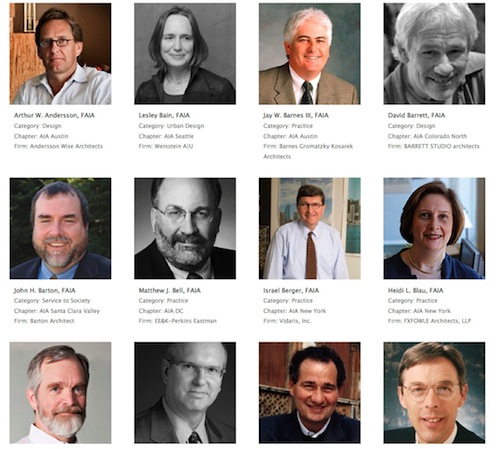The 2013 Jury of Fellows from the American Institute of Architects (AIA) elevated 122 AIA members to its prestigious College of Fellows, an honor awarded to members who have made significant contributions to the profession. The 2013 Fellows will be honored at an investiture ceremony at the 2013 National AIA Convention and Design Exposition in Denver.
SEE THE LIST OF 2013 AIA FELLOWS
The Fellowship program was developed to elevate those architects who have made a significant contribution to architecture and society and who have achieved a standard of excellence in the profession. Election to fellowship not only recognizes the achievements of architects as individuals, but also their significant contribution to architecture and society on a national level.
2013 Jury of Fellows
Linda Searl, FAIA, (jury chair) Searl Lamaster Howe Architects; John Castellana, FAIA, TMP Architecture, Inc.; Brian Dougherty, FAIA, Dougherty + Dougherty Architects, LLP; Leevi Kiil, FAIA, Leevi Kiil Architect; Susan Maxman, FAIA, SMP Architects LTD; Craig Rafferty, FAIA, Rafferty Rafferty Tollefson Lindeke Architects and Raymond Yeh, FAIA, Yeh Studio.
Out of a total AIA membership of over 83,000, there are just over 3,100 distinguished with the honor of fellowship and honorary fellowship. The elevation to fellowship is conferred on architects with at least 10 years of membership in the AIA in one or more of the following nomination categories:
1. Promoted the aesthetic, scientific, and practical efficiency of the profession
2. Advanced the science and art of planning and building by advancing the standards of architectural education, training and practice
3. Coordinated the building industry and the profession of architecture through leadership in the AIA or other related professional organizations
4. Advanced the living standards of people through an improved environment
5. Made the profession of ever-increasing service to society
Included in the list below are the newly elevated members, their component affiliation and category for which they were elevated.
2013 Fellows
Included in the list below are the newly elevated members, their component affiliation and category for which they were elevated. You can follow the link below to view a more detailed list that includes images: http://www.aia.org/practicing/awards/2013/fellows/index.htm.
About The American Institute of Architects
Founded in 1857, members of the American Institute of Architects consistently work to create more valuable, healthy, secure, and sustainable buildings, neighborhoods, and communities. Through nearly 300 state and local chapters, the AIA advocates for public policies that promote economic vitality and public well being. Members adhere to a code of ethics and conduct to ensure the highest professional standards. The AIA provides members with tools and resources to assist them in their careers and business as well as engaging civic and government leaders, and the public to find solutions to pressing issues facing our communities, institutions, nation and world. Visit www.aia.org.
Related Stories
Cultural Facilities | Feb 25, 2015
Edmonton considering 'freezeway' to embrace winter
If the new Edmonton Freezeway is constructed, residents will have an 11-km course that winds through the city and allows them to skate to work, school, and other city activities.
Building Team | Feb 24, 2015
Call for entries: 2015 Giants 300 survey
The annual Giants 300 Report ranks the top AEC firms in commercial construction, by revenue.
Industrial Facilities | Feb 24, 2015
Starchitecture meets agriculture: OMA unveils design for Kentucky community farming facility
The $460 million Food Port project will define a new model for the relationship between consumer and producer.
University Buildings | Feb 23, 2015
Future-proofing educational institutions: 5 trends to consider
In response to rapidly changing conditions in K-12 and higher education, institutions and school districts should consider these five trends to ensure a productive, educated future.
Office Buildings | Feb 23, 2015
The importance of quiet and the consequences of distraction
Recent work style studies show that the average knowledge worker spends 25-35% of their time doing heads-down focused work. Once thrown off track, it can take some 23 minutes for a worker to return to the original task.
Modular Building | Feb 23, 2015
Edge construction: The future of modular
Can innovative project delivery methods, namely modular construction, bring down costs and offer a solution for housing in urban markets? FXFOWLE’s David Wallance discusses the possibilities for modular.
| Feb 23, 2015
6 trends changing the way city dwellers live
Across the cultural grid, from food to retail to transportation, America's urban areas are already undergoing a major metamorphosis. Here are the six major trends shaping our cities, from Fast Company.
Green | Feb 23, 2015
State of the green union, and the next big shift in sustainability
The history of the green movement offers cues that we are on the precipice of another significant shift in the green union.
| Feb 23, 2015
Where are the iconic green buildings?
What does a green building look like? How would you know one if you saw one? Maybe a trivial question to some, but of great interest to architects, designers, and other members of the Building Team as the rapid evolution of sustainable buildings continues apace.
Sports and Recreational Facilities | Feb 21, 2015
Pumped-up recreation centers help build body, mind, and spirit
Adopting facility layouts from Asian and European models, today’s sports and recreational buildings are becoming social hubs that accommodate a variety of community needs.















